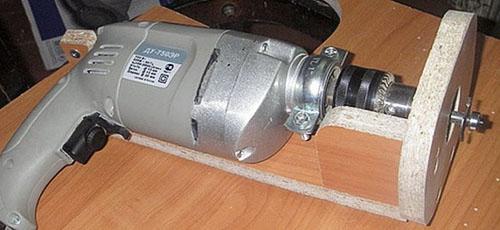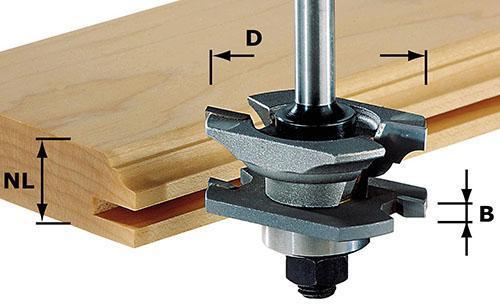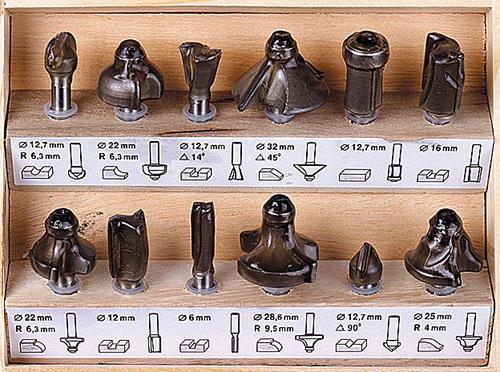We select cutters for a drill
 The main functional part of the drill is a motor that drives an electric shaft. In the future, the load is transferred to the actuators, one of which may be a cutter for a drill. A cutter represents a tool, like a screwdriver or drill. Depending on the configuration and width of the cutting part, depressions of various profiles, grooves and grooves can be created in the body of the workpiece.
The main functional part of the drill is a motor that drives an electric shaft. In the future, the load is transferred to the actuators, one of which may be a cutter for a drill. A cutter represents a tool, like a screwdriver or drill. Depending on the configuration and width of the cutting part, depressions of various profiles, grooves and grooves can be created in the body of the workpiece.
Features of working with a drill with a cutter

Use drill as a router is possible only in some cases. The reason is the high precision of work, great effort on the drive. Drill cutters are specially designed taking into account the power and ways of adjusting the device. The shape of the drill and its center of gravity are of great importance for work.
Features of using a drill cutter:
- a change in the load vector can damage the gearbox if additional pressure is applied to the workpiece;
- the motor overheats, frequent rest is required;
- the load on the plastic case can lead to the anchor skewing and deformation;
- fastening in a chuck with a horizontal axis of operation is unreliable.
All this suggests that the drill as a router works in an unusual position and with uncharacteristic directions of resistance forces. To work with a milling attachment for a drill, you need to slowly, with caution.
Woodwork
 The tool is a shank for fixing in a chuck and a cutter, which is made of special steel. Initially, the cutter is sharpened for a specific operation. The rigging is made with strict precision to eliminate backlash. Sharpening and hardness steel are matched to the characteristics of the material being processed.
The tool is a shank for fixing in a chuck and a cutter, which is made of special steel. Initially, the cutter is sharpened for a specific operation. The rigging is made with strict precision to eliminate backlash. Sharpening and hardness steel are matched to the characteristics of the material being processed.
It is better to select the profile and depth of cut on a sample of material of similar hardness. In this case, the drill is installed in clamps at the required distance and the speed is selected corresponding to the work performed.
For drill bits, only end mills with a shank are used. For long-term work without sharpening it is better to choose plywood cutters. You cannot sharpen them yourself.
Wood cutter for a drill differs in the type of processing:
- ruffles - round the corners;
- V-shaped - make a sample in the body of the workpiece;
- disc and folded - create grooves;
- fillet - an internal groove on the edge;
- dovetail - tongue-and-groove connectors;
- edge - process the edges of the planes.
Wood cutters are distinguished by their soft effect on the material in order to prevent chipping and hardening of the edge to brittleness.
Features of shank cutters for metal processing
 Metal is a solid material with a uniform crystal lattice. It is processed rigidly, the main indicator is the speed of work.
Metal is a solid material with a uniform crystal lattice. It is processed rigidly, the main indicator is the speed of work.
Depending on the desired result, metal cutters of various configurations are used for a drill:
- end;
- corner;
- cylindrical;
- disk;
- end.
End cutters are used for vertical metal processing. More often they process the plane.
If the teeth are located on the end and side edge of a flat disk, you can drill a recessed profile on the plane. This is how grooves and grooves are made. If you use not a disk, a cylinder with smoothly curved grooves, you can process a horizontal surface, remove a layer, smooth out irregularities. For each operation, a special metal cutter for the drill is selected. In this case, remember about the load on the motor and bearings, not allowing the tool to overheat.
The requirements for the manufacture of cutters are tough. The tool must work efficiently, maintaining the sharpness of the cutting surface for a long time. Often, in order to save expensive carbide steel, cutters are made prefabricated, the body is made of ordinary steel, and the teeth are made of alloys.
Cutters should only be purchased from reputable manufacturers. At the same time, check the quality of sharpening, the uniformity of the structure, pay attention to the material of the cutting edge. Especially check the tightness of the precast cutters.
A milling cutter, like any cutting tool, requires careful handling. The cutting edge does not tolerate heat, vibration, and improper use.
We process plastic with a drill with a cutter
 A special feature of plastic processing is its viscosity. When the cutter is exposed to a high speed, the plastic first begins to wrap around the cutter and then liquefies. Therefore, the selection of drills and the processing speed of each polymer causes certain difficulties. A cutter for plastic for a drill is selected depending on the type of material:
A special feature of plastic processing is its viscosity. When the cutter is exposed to a high speed, the plastic first begins to wrap around the cutter and then liquefies. Therefore, the selection of drills and the processing speed of each polymer causes certain difficulties. A cutter for plastic for a drill is selected depending on the type of material:
- thermoplastics;
- thermosets.
From the name it is clear that thermoplastics under the influence of temperature acquire fluidity, the chips of such materials drain, with melted edges. Reactoplastics are not subject to softening when heated. Often this material is produced with reinforcement. Based on the properties of the polymer, cutters and processing mode are selected.
Thermosetting plastics are processed with multi-start cutters, while maintaining smooth processing. The depth of one cut should not exceed 2.5 mm. Otherwise, you can get the destruction of the treated surface. Taking into account the artificiality of the material, it is necessary to organize the suction of microparticles so that dust does not get into the respiratory organs of the worker.
Cut soft material with two-start cutters at low speed so that the material does not "flow". For plastic sheets, it is better to use a compression cutter for edging.
We mill concrete with a drill
 If there is a need to process the structure with a concrete cutter for a drill, diamond core bits with external cutters are used. The cutter is unscrewed from the base, the shank. The victorious layer cleans the hole well, provided that a powerful drill works in a non-impact mode. Such crowns are used to remove ceramic tiles from the wall, for fine cleaning.
If there is a need to process the structure with a concrete cutter for a drill, diamond core bits with external cutters are used. The cutter is unscrewed from the base, the shank. The victorious layer cleans the hole well, provided that a powerful drill works in a non-impact mode. Such crowns are used to remove ceramic tiles from the wall, for fine cleaning.
The use of victorious drill bits for drilling is dangerous. The drill must be held firmly, expecting a jerk, as the density of the material in the wall may change, and the force of impact will create a shock.
Why do you need a magnetic drill
 When developing a drill on a magnetic bed, we were guided by the problem of creating holes in multi-ton metal structures that cannot be moved. Farms such as a large magnet attract a pair with an opposite charge. The creation of a charged drill bed solved the problem of securing the tool for drilling holes with high precision.
When developing a drill on a magnetic bed, we were guided by the problem of creating holes in multi-ton metal structures that cannot be moved. Farms such as a large magnet attract a pair with an opposite charge. The creation of a charged drill bed solved the problem of securing the tool for drilling holes with high precision.
Drilling in metal of large cross-section holes is performed with different nozzles, including using a milling cutter for a drill on a magnetic bed. Typically, this tip is used as a hollow crown. Drilling with a magnetic drill along the markings is guaranteed to be accurate. As long as voltage is applied to the bed, the drill is held flat with a force of several tons per square centimeter. After turning off the current, the installation can be easily moved to a new place, its weight does not exceed 25 kg.
The slot cutter can drill a hole in the structure up to 130 mm in diameter.